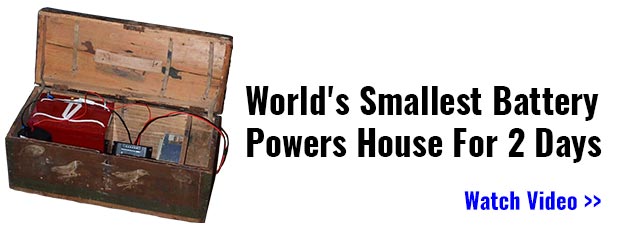Many of us in the prepping movement have a dream of owning a cabin in the woods somewhere, which we can use as a weekend getaway, as well as a survival retreat. The only problem is that such properties are extremely expensive, if you can find them. Selling our home to pay for that isn’t practical in many cases, as we need to be in town for work. That leaves us wishing for the cabin, while wondering what to use for a survival retreat, should we ever have to bug out.
Since I don’t have a cabin in the woods, my bug out plan is to relocate to a small rural town that my wife and I visit regularly. It’s far enough away from the small rural town we live in, so that it shouldn’t be affected by any disaster that hits out town, while still being close enough to reach in a reasonable amount of time and with one tank of gas. Part of the reason we visit it regularly, is so that locals know us and will hopefully accept us if we have to bug out there.
But that doesn’t eliminate my desire for that cabin in the woods. At this point, I’ve pretty much decided I’ll never have it, for the same reason most people don’t have one… I can’t afford it. But that hasn’t stopped my search for a way to get myself a place out in the woods. It may not be a cabin, but I think my idea will still work.
It surprises me how few preppers think of recreational vehicles for bugging out. One of the Facebook groups that I’m on, which deals with bug out vehicles, seems to show a lot of extreme RVs, many of which use a military vehicle of some sort as the base. Some of those are homemade and some that cost an arm and a leg. But normal RVs seem to be pretty scarce in the prepping community.
Click HERE to Get the World’s Smallest Battery,
That Powers Your House For More Than 2 Days!
Yet there’s a lot to be said for RVs in a bug out. Granted, they are gas hogs and unless you’re going to do one of those based on a military chassis, you can forget about going off road. Even going across a rough parking lot can be a bit iffy in one of them. Even so, how many other ways are there that you can drive your cabin to the woods? Not only that, how many other vehicles provide you with all the modern conveniences, in a portable package?
You can buy used RVs, especially travel trailers, fairly inexpensively, especially if you’re willing to get one that needs a bit of work. Customizing your RV with some new interior finish is about like customizing a van, something that some people really enjoy.
Land
The bigger challenge for most of us isn’t getting the RV, but rather getting the land to park it on. There are several options possible for this, like using land belonging to a friend or family member. If you have someone in your circle who lives out in the country, you should probably be talking to them about survival strategies and using their place as a retreat anyway. Hopefully they’ve even got enough space that you could leave your RV parked there on a regular basis.
A second option would be to use a campground as your survival retreat during a bug out. It’s doubtful that there will be a whole lot of people who think of going camping, while there’s a bug out. If you can establish a relationship with the people who run the campground, you might be able to make arrangements to reserve a spot, ensuring you have someplace to go.
A third option might be to buy some property to park your trailer on. I realize that may sound contradictory, after saying that most of us can’t afford a cabin in the woods; but hear me out. There’s a thing known as “junk property.” This is land that really isn’t marketable, mostly because it isn’t really usable for much of anything. It’s not near any population center, so there’s no reason to build businesses or homes there. Nor is it good for agriculture, either because it doesn’t have water available or because the soil won’t support growth. Such land is available cheap, usually for a couple of thousand dollars or less, per acre.
You won’t find junk land listed by real-estate companies, and anything they list, calling it “junk land” is going to cost much more than it should. If a real estate company is selling it, they’re trying to make a profit. You’re either going to have to find the land by chance, driving through an area or advertise for it, hoping to get a landowner that sees your ad. You’ll get a lot of response from real estate agents too, but you can just ignore those.
One of the most important things to check on is to verify that you’ll have access to your property. If there isn’t a public road that passes by the property, you may need a separate signed agreement with a neighbor, giving you access to cross their property. Without that, you could end up in a sticky legal battle at some point in the future.
Be sure to check whether the land for flooding; is it within a 100-year flood zone? That information is available online, on the USDA website, so you don’t need to get it from the person who is selling the property. You don’t want to be leaving your home to go to your retreat, only to find that your retreat is underwater.
Land purchases like this are usually handled as personal transactions, without the services of real estate agents. So, you’ve got to be aware of what you’re doing, making sure that you don’t get ripped off. It’s unlikely that you’ll find a scammer that is using this as a ruse, but the person selling you the land may not know any more about what they’re doing than you do. That can cause legal problems, if the paperwork isn’t handled properly.
Buying a couple of acres of this junk land provides you with someplace to set up your RV permanently or to take your RV to, in the event of an emergency. However, it would be a good idea to do some improvements to that property, making it a better place to park.
Setting Up for the RV
Junk land is not going to have any utilities available on it. Bringing those in would probably be cost-prohibitive, helping to explain why the land is so cheap. But your RV’s tanks and batteries only hold so much fresh water, propane, waste water, gasoline and electricity. If you’re going to be there more than a couple of days, you’re going to need some means of replenishing them.
This means putting in your own services on the property, without connecting them to public utilities. It’s possible to do all this, over time, making your survival retreat functional for a prolonged period of time.
- Storage – To start with, you’re going to need storage for supplies, the space available in any RV for food is limited. The easy way to get this is to set a shipping container on the site. Used shipping containers are fairly inexpensive and they are secure, giving you a great place for your stockpile.
- Water – your biggest problem is going to be having enough water, as you won’t have water on-site. I’d recommend setting up a few IBCs (intermediate bulk containers) and carrying water out to fill them, each time you visit. It will take some time, carrying water out there 55 gallons at a time; but you can stockpile enough water to last. Hopefully you can find a natural source nearby, like a lake or stream, that you can pump water out of. Then put in rainwater capture as a more permanent solution.
- Electricity – The roof of your RV and shipping container both offer space to install solar panels, giving you some capacity for producing electricity. In many areas, this capacity can be improved upon by adding a wind turbine, mounted to a corner of the container.
- Propane – This one is a bit of a problem, as you can’t harvest propane from nature yourself. However, you can have a propane company put in a 500-gallon tank for you, filling it. That will be enough to last quite a while, if you use it cautiously.
- Sewage – The RV’s tanks will tend to fill quickly, needing dumping. A simple solution is to make a septic system out of a couple of 55-gallon plastic drums. Have the waste water flow into the first one, so that solids can settle, then have the overflow from that one go to a second drum, for further settling. Water from there, called “effluent” can then go into pierced 4” PVC piping, buried underground, to be absorbed into the ground and then evaporate.
These aren’t permanent solutions; but they should allow you to stay in your survival retreat for several months. By then, you should either be able to return home or be working on a more permanent place to live. In either case, you’ll have a comfortable place to go to, should an emergency ever force you to bug out, as well as a good weekend retreat for your family.
Another thing I would do on any property that doesn’t already have a lot of trees is to plant trees, including some fruit-bearing ones. Trees will provide you with shade, help to screen your retreat from prying eyes and ultimately provide some fruit for your family to eat.
Make sure you secure everything well, as things which are left alone are an open invitation to thieves. The last thing you need is to show up at your retreat, escaping a disaster, only to find that someone stole your food, water or RV.



























